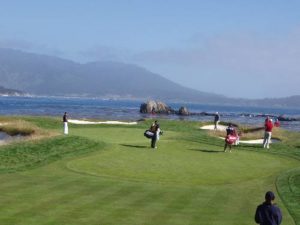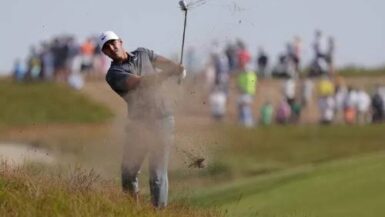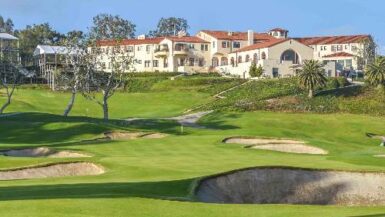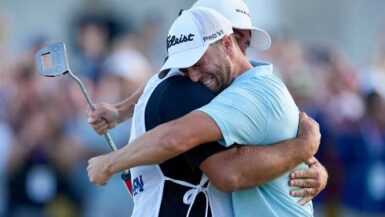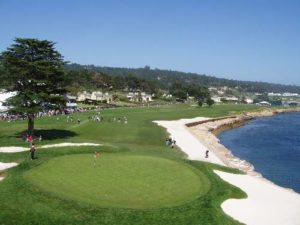
DEL MONTE FOREST, CA – Take a moment to deeply savor the fragrant breeze off the Pacific Ocean. Close your eyes and listen to the gentle rustle of the waves, its somnambulant trance broken only by the mournful baying of the sea lions as they frolic on the beach. Take one last look at the cherry rays of the dying sunset over the Pacific as your legs dangle off the cliff edge, the last vantage point of the Western World.
And then crown a champion in the gloaming, before going off to celebrate long into the cypress-scented, zephyr-cooled night.
That’s our beloved Pebble Beach, America’s answer to Scotland’s Turnberry. It’s beautiful, it’s ancient, it’s historic, and it never ceases to mesmerize. Better still, Pebble Beach, celebrating its centennial this year, saves its wildest drama for the biggest stages; it’s never more captivating, electrifying, or flabbergasting than when a major championship comes to idyllic Monterey Peninsula.
Its first Open, 1972, was also the first U.S. Open held on the West Coast since Ben Hogan won at Riviera in 1948. For the first time in a generation not only was there a west coast national championship, it was beamed to a prime-time national television audience. Golf on the edge of the world was seen in brilliant color in the homes of millions, and what did they see? Not just, arguably, the most scenic American golf course built at that time, but Jack Nicklaus, golf’s mega-star still in full ascension, completing the second leg of the Grand Slam.
Nicklaus won wire-to-wire, but not without dogged pursuit all week long. His 1-under 71 on Thursday shared the lead with five others, but they were more a comedy act than a Murderer’s Row. (Orville Moody, Kermit Zarley, Chi Chi Rodriguez, Mason Rudolph and Tom Shaw.) After Round 2 he was tied at even par with Zarley, Bruce Crampton, Lanny Wadkins, Homero Blancas and Cesar Sanudo.
Cesar Saludo is not the guy who played the Joker opposite Adam West’s TV Batman, but your confusion is easily forgiven.
But things changed dramatically as our heads hit the pillow on Saturday night. Nicklaus finally had the lead by himself at even par, but Lee Trevino, the defending U.S. and British Open champion had clawed to within one shot, along with Zarley and Crampton, who refused to go quietly. Trevino had been hospitalized with bronchitis for several days and was released only two days before the Open. (He ultimately finished tied for fourth.) And Arnold Palmer and Johnny Miller had also hung around, lurking just two shots back at 2 over.
Then the wind turned the place into Kansas. Dorothy and Auntie Em’s farm to be exact, and when the dust had settled on Sunday here were the scores of the players who finished second through tenth:
Bruce Crampton: 76
Arnold Palmer: 76
Homero Blancas: 75
Lee Trevino: 78
Kermit Zarley: 79
Johnny Miller: 79
Tom Weiskopf: 78
Chi Chi Rodriguez: 75
Cesar Sanudo: 77
It wasn’t just Shakespearean-in-magnitude drama, it was freaking King Lear. (Blow winds! Rage! And crack your cheeks! Rage! Blow!)
Nicklaus’s 2-over 74 to close may look like an aberration on paper, and for about 30 years it had the dubious distinction of being the highest closing round by a U.S. Open winner, but it’s one of the greatest gut-check rounds in golf history. Moreover he gave us a time capsule golf shot in the clutch to close out the tournament: a lightning bolt to close, a dagger and exclamation point, whatever you want to call it. Maybe God can’t hit a 1-iron, but Jack Niclklaus sure did, in the biggest way, to seal the 1972 U.S. Open on the toughest hole on the golf course, the brutish, 190-yard, par-3 17th. His 1-iron, described once as being as small as a steak knife, tore through the tempest like an arrow, landing a foot from the cup, hitting the pin, dancing around the hole for a moment, then sitting like an obedient dog for a kick-in birdie on the hardest hole on the golf course.
With that one shot, Pebble Beach became world-famous.
True greats always come back for an encore, and the Golf Gods that inhabit Pebble have a definite sense of occasion. If they could have spoken to us in 1982, the next time the Open came to Pebble, they’d have said something like, “Oh you like Jack’s 1-iron at 17? HOLD MY BEER…”
The 1982 Open was, for Tom Watson, the best chance he would ever have to win the national championship. He was in full ascension, having won two Masters and – already at that time – three British Opens. On two of those occasions, he’d gone one-on-one with Jack Nicklaus and won.
But Watson was wild off the tee. The Golf Gods do not give a player everything: Nicklaus couldn’t hit a wedge, Trevino couldn’t hit a hook, and – like Tiger Woods – Watson had driver issues. Under normal circumstances, the U.S. Open, with its 5-inch rough and 25-yard wide fairways, was the unlikeliest major for him to win.
Unless the U.S. Open was played on a windswept links. And in particular, unless it was played on a course close that Watson knew as well as he knew his own soul: a course like Pebble Beach. Watson played golf for Stanford; he snuck onto Pebble Beach before sunrise nearly every single day during college. And although it is not built on actual linksland, with its fierce swirling winds, it was, at that time, the closest thing to a British Open Rota course that America had.
And except for Young Tom Morris, no one played major championship links golf better than Tom Watson. If he was ever going to win the U.S. Open, this was his best chance.
After three rounds, Watson had perched himself atop the leader board with reigning British Open champion Bill Rogers at 4 under, two shots clear of a logjam of four players, including defending champion David Graham. Nicklaus was three back at 1 under.
Watson picked a perfect day to hit 13 of 14 fairways. He needed them too. His iron shots, normally so laser perfect, betrayed him in the fickle Pebble Beach winds. He hung a 7-iron out to the right on the dangerous, cliff-side par-4 10th, but the bunker saved him from crashing to the surf below. It’s still an unenviable place, a good 7 feet below green level, but at least it wasn’t a penalty.
Watson got up and down, holing a 25-footer for par.
Then Watson rolled in a 25-footer on 11 for birdie. And then another 35-footer on 14 that had to break 5 feet. These were gargantuan putts from across the green. “Putts you just don’t make,” as Watson himself admitted, but you came to expect them from Watson. Lightning could strike at any time off his putter or wedge. Even his wife would try to call up the magic juju like a mesmerist. “Come on, we need a snake…come on we need a snake,” she’d say to herself over and over again, meaning one of those maddening, double-breaking, 35-foot, “How the hell did he make that?” putts that were Watson’s trademark and secret weapon.
He needed every one of those. Nicklaus was charging hard. After spinning a wedge off the first green for bogey and merely parring the par-5 second, Jack ran off five birdies in a row to vault into a tie for the lead, and he and Watson played cat and mouse alone for the remainder of the day.
Watson’s only missed fairway came at 16. His tee shot landed in the brand new bunker put in expressly by Deane Beman for that purpose: to catch a leader coming down the stretch. It led to a bogey that dropped Watson into a time for the lead with Nicklaus, who had finished and was watching on television.
It’s a shame that the place where Watson holed his time capsule chip doesn’t exist any more, because as the great ABC broadcaster Peter Alliss said “It is a shot that will be remembered as golf is continued to be played.”
With that shot, Pebble Beach became immortal.
If 1972 was King Lear, and 1982 was golf’s Miracle on Ice, then 2000 was a Godzilla movie. A force of nature named Tiger Woods, also forearmed with a Stanford alum’s knowledge of the golf course dissected Pebble Beach like a doctor performing open-heart surgery — only instead of repairing the heart, he ate it whole. Tiger’s 12-under 272 not only tied the aggregate scoring record at that time, he won by a whopping 15 shots. No one else even broke par. The next best score was Miguel Angel Jienez’s 3-over 287.
With that, Pebble Beach became transcendent.
It led Ernie Else to openly grouse, “If he wins by 15 at St. Andrews [where the British Open was played the following month], there ought to be an inquiry.” Woods won by only eight.
Which brings us to 2010 – the last time the Open came to Pebble. That Sunday was comedy night at the Apollo, and everybody flopped.
As championship Sunday dawned that year, rising star Dustin Johnson had a three-shot lead over Graeme McDowell, with Tiger Woods, Ernie Els and Phil Mickelson right behind. But as we all know, Pebble Beach in February for the AT&T Pebble Beach Pro-Am (which DJ won) is not the same Pebble Beach we see for the Open. Suddenly, there is a minefield of unexploded double bogeys lurking, waiting to go off at the slightest provocation.
They may be speaking about Augusta National and the Masters when they say “the tournament doesn’t begin until the back nine on Sunday,” but you can say the exact same thing about Pebble Beach. There’s only one problem: Instead of hitting the gas and going as low as possible, at Pebble Beach, the back nine is hang on for dear life.
DJ’s lead was not safe, and the best players in the civilized world were lying in wait.
Right on cue, DJ turned into your Old Aunt Sally trying to play golf. He lost a ball, he had to hit one shot left-handed, he stubbed a chip, and he fluffed one in the rough. After just three holes, he had lost six strokes and the door was wide open for the rest of the field.
And they the all did their best to bang their heads on the door jamb stepping through. Remember those terrible back nine scores from 1972? They came back with a vengeance. Woods, Mickelson and Els shot 37, 39 and 40 respectively on the back nine, and played the critical stretch of 8, 9 and 10 a combined 10 over par. Woods drove all over Monterey en route to bogeys at 1, 4, 6, 8, 10 and 12. Phil flailed in the rough haplessly, and Els double-bogeyed 10, then bogeyed 11, 14 and 17.
Even with his own 38 on the back nine, McDowell held on for a one-shot win over Frenchman Greg Havret, who went back to obscurity as quickly as he emerged. Though his closing 74 is the highest final round by a U.S. Open winner since Andy North at Oakland Hills in 1985, and matches Jack Nicklaus’s 74 to win at Pebble in 1972, McDowell was T-3 for the week in putting and T-12 in greens in regulation. Putting and greens in reg: That’s the formula for winning the U.S. Open.
So as we look towards this Championship Sunday, the biggest question is whether Brooks Koepka can become the first three-peat U.S. Open Champion since Willie Anderson in 1900s. If the wind blows, don’t bet on it. Like early Tiger Woods, Koepka still hasn’t mastered playing in strong ocean winds. He had trouble down the stretch at Bethpage when the wind kicked up and struggled early at Shinnecock before the weather calmed on the weekend.
Koepka will also be coming into the tournament as only the fifth player to capture both PGA Championship and U.S. Open in same year, and he’ll be attempting to be the first to do it back-to-back. Nicklaus, Woods, Sarazen and Hogan are the others. Nicklaus did it in 1980 at Baltusrol and Oak Hill. Sarazen in 1922 won the Open at Skokie and PGA at Oakmont. Then in 1948, Ben Hogan won the Open at Riviera and the PGA at Norwood Hills in St. Louis at match play.
California is a weird place, and Pebble has an energy all its own. It’s one of the shortest courses in our informal American rota, but also one of the fiercest with its tiny, curvaceous, bumpy poa annua greens, the yawning chasm of the ocean-side cliffs, deep, gnarly rough, ball-grabbing ice plant, and ever-changing winds. Its brilliance as a golf tournament venue is only surpassed by the enchanting scenery. No matter who lifts the trophy come Sunday night, Pebble Beach will win the Open, like I always does. And that means the golf viewing public wins too.
